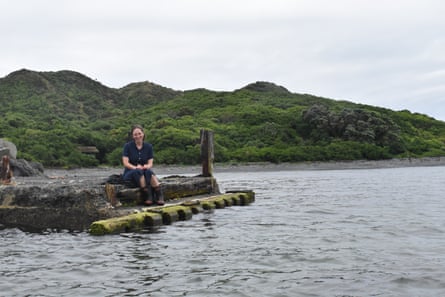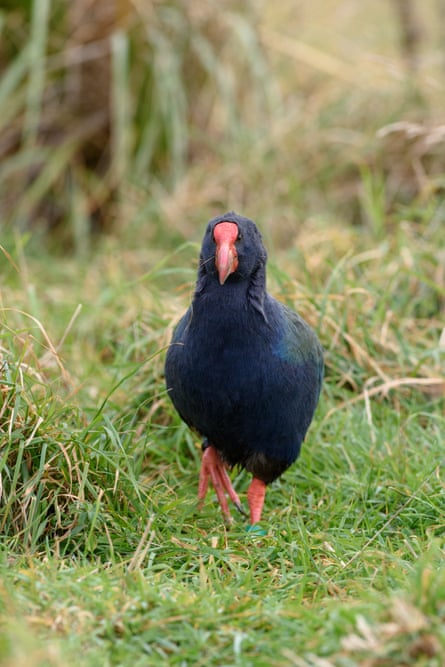The island where I live, Te Mana o Kupe o Aotearoa, sits half an hour off the coast of New Zealand’s north island. It has one house and a permanent human population of two: my husband, Pat, and me. In April, this will increase to three because we’re having a baby.
From the mainland, Mana looks exposed. It rises from the sea like a stone slab. Once here, the view flips. The mainland lounges across the horizon and the island reveals itself as a lush, green refuge from Cook Strait’s battering swell.
With its calm gaze toward Porirua, Mana Island is treasured by Ngāti Toa Rangatira, the mana whenua iwi. Te Rangihaeata lived here: chief and nephew of Te Rauparaha, who wrote Ka Mate.
From the 1830s, the island was farmed by the Vella family but in 1987 became a sanctuary for nature, managed by the Department of Conservation (DOC). They shipped off the cattle and, with the community group Friends of Mana Island, replanted 500,000 native trees over the pasture. Vines grew over the fence posts. Birds flocked back to the bush. Today, Ngāti Toa and DOC work together on a vision for Mana.

Time unfurls differently here. Pat works for DOC so our rhythms follow his shifts. Ten days on, four days off. When each stint ends a boat picks us up and we sail to the mainland to visit our families and see the midwife. After the weekend, we haul 10 days’ worth of food into the boat and get dropped back on Mana’s small, rocky beach. Our first island task is always the same: in the quarantine station we inspect all our supplies – oranges, cheese, clothes, library books – for stowaway mice or invasive seeds.
I’m writing, and working remotely for a library on the mainland, but I spend a lot of time exploring Mana. You can loop around it in two hours on an easy day – when the wind drops and seagulls aren’t swooping – but I go slow. I peer at seashells and learn plant names to tell the baby.
I can’t shake the mainland, I say to Pat one autumn evening just after we’ve moved. We’re wandering around together as he wraps up his workday. He reverses the quad bike into the island’s huge shed and stows the barrel of bird feed. When he rolls down the garage door, I mistake its barking clanks for a labrador. The birdsong that carries into our house sounds like cafe chatter, a lingering soundscape of suburban instinct.
Pat looks after Mana’s takahē. He monitors their territories, feeds them and vaccinates them against beak rot. As I watch takahē going about their ordinary beaky days I think, none of these lovely blue birds know how rare they are. Less than 500 exist in the world and six breeding pairs live here. All 500 have names: here is big, hungry Hana, with her shy mate, Govan. Over there, Pukekohe and his Astelia, who has the longest, reddest legs on the island.
Flightless birds get patronised for evolving away from flight (cf. the dodo) but looking at stout, purposeful Astelia it makes sense to me. Her legs remind me of a dinosaur’s, all red scales and wide, clawed feet. A takahē’s round blue body, tucked under her iridescent green back, gives the impression of planet Earth, if it were swallowed by a chicken.

And they still have the wings; each one is equipped with a single knifelike spur.
Takahē start nesting in spring. They mostly plop down in tussocky toetoe, high up the island. I think about them constantly as my pregnant tummy gets bigger, like I too have stuffed a globe down my jumper, waiting for my chick to hatch. Out the kitchen window one sunny afternoon, I spot two takahē, with a leggy chick, pottering in our vegetable garden. They pick out the weeds.
Mana’s abundant, daring pūkeko are less considerate. Babe! The pūkeko are in the compost again! I shout to Pat one day. He runs out to shoo them away, laughing.
At night, while takahē and pūkeko sleep, different animals appear. I escort little brown geckos from the bathroom while I brush my teeth and, in our bedroom, we hear kororā honking and huffing in their nests. These penguins are like babies, teeny tiny but super loud. They seem to prefer storms, bellowing even louder over the rain and huge seas that sometimes keep us here beyond our 10-day shift. Some nights, it feels as if the whole island is shouting and singing.
In the morning, we can see where kororā have been, where they’ve waddled from their nests back to the newly calm sea for breakfast. Their commute leave trails crisscrossing the wet grass, like giant wobbly snails or public servants heading into the Cook Strait for work.
Soon, the takahē chicks will shed their black fluff and turn blue. My body is round like a Swiss ball. Today, I waddled down to the beach for a swim but I was barked off by seals sunbathing on the hot pebbles.
All this begins to feel normal and my mainland instincts shift. Last weekend in the city, I kept mistaking sparrows for little brown geckos. I walked very slowly and peered at bottle caps stuck in the road. I hoped for calm seas and a quick return to my nest on Mana.
Flora Feltham is a writer, weaver and archivist from Wellington. She lives on Mana Island.

 1 year ago
89
1 year ago
89










 English (US)
English (US)